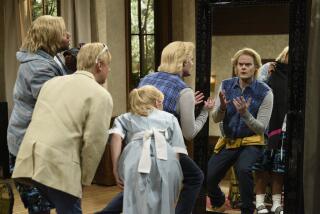L.A. cartoonist was obscure and misunderstood — the epitome of avant-garde
- Share via
One hundred-plus years after the newspaper comic strip was born in San Francisco, a reader might well ask: Who was the greatest comic artist of all time? Some scholars say the question was settled in 1924 by New York arts critic Gilbert Seldes, whose book on the American cultural scene, “The 7 Lively Arts,” devoted an entire chapter to a reclusive cartoonist in the Hollywood Hills named George Herriman and his avant-garde comic strip, “Krazy Kat.”
Although President Woodrow Wilson, a notorious egghead, and writers T.S. Eliot and Gertrude Stein were fans and newspaper magnate William Randolph Hearst was an ardent supporter, Herriman’s dialect-heavy but poetic strip was a problem for many newspaper editors and most readers — where were the jokes?
The drama of “Krazy Kat” played out against a nocturnal desert landscape, Herriman’s scratchy drawings depicting the strange love-hate triangle of Ignatz, an ill-tempered mouse, Krazy, an innocent “kat” of indeterminate gender who loves Ignatz, and Offissa Pup, a canine “kop” determined to prevent Ignatz from smacking a strangely appreciative Krazy on the “bean” with a brick.
The strip not only baffled adults (Krazy’s mangling of English easily outstripped that of Popeye: “Wotta reckliss life a ‘pen cake’ has got to contempt with — if it ain’t a flip, it’s a flop — ruint — kimplickly ruint”), but apparently the shy cartoonist was working under the delusion that he was appealing to children as well. Editors knew better, often complaining to Hearst: “they don’t get it.”
It was Hearst alone who ensured Herriman’s livelihood. The Chief, as he was called, had a good eye, and he liked what he liked. From 1913 to 1944, the strip appeared in a select handful of Hearst newspapers, often running in the arts and culture section.
George Joseph Herriman was born in 1880 in New Orleans but grew up in a neighborhood south of downtown Los Angeles near Washington Boulevard and Main Street. His father, George Herriman Sr., was a Spring Street tailor who may have also moonlighted as a baker. The 1898 L.A. City Directory lists Herriman Sr. as being employed by the Royal Bakery Restaurant at 118 S. Spring St.
Herriman attended St. Vincent’s Academy, a Catholic boys’ school. As an adult he was quiet and retiring, but funny. In person and in his letters, his impish humor tended toward the self-deprecating, and he seemed to hate being photographed, perhaps self-conscious about his mixed Creole ancestry.
“Well, here’s the ‘old man’s’ picture,” he wrote to a trade magazine in 1922. “Any fella with a face like that should keep it a secret from the public, and I can’t see how you’re going to get any circulation publishing mushes like that!” His modesty may have been partly for show, but he did once try, unsuccessfully, to return money to Hearst after an unannounced pay raise.
Recounting his childhood, Herriman loved to tell stories of working as a baker’s apprentice downtown. “Full of the spirit of adolescence,” Herriman wrote in 1922, “I buried a dead mouse in a loaf of bread once.” He also claimed that falling off a scaffold ended his teenage career as a sign painter.
In 1900 he went to New York City to start up his cartooning career, but by 1906 he was back in Los Angeles, where he lived at 4208 Herriman Street (which doesn’t exist today, leaving another small mystery for his biographer, Michael Tisserand, to unravel).
The 1920s was his golden decade. “Krazy Kat” was adapted for Broadway in 1922, and Herriman was inducted into Vanity Fair’s monthly “Hall of Fame.” By 1930 he was earning enough to build a two-story Spanish-style house on Maravilla Drive, high above the Hollywood Bowl.
Herriman’s idyllic artist-life was scarred forever when his wife, Mabel, was killed in a car accident in 1931 and his daughter Bobbie died a few years later. If there are letters expressing Herriman’s anguish, they have yet to surface, but we know that after Mabel’s death he set up a small workspace at the Hal Roach Studios in Culver City (the “Lot of Fun”). While there, he no doubt enjoyed working in the company of fellow gag-writers, including his close friend H.M. “Beanie” Walker, who wrote for Laurel and Hardy films.
When Herriman died in 1944 it was decided that “Krazy Kat” was a certified work of art that could never be ghosted by another artist. Immortality quickly followed: In 1946, poet E.E. Cummings wrote the introduction to the first hardcover collection of “Krazy Kat” strips, the beginning of a steady stream of reprint books that continues to this day.
“Be not harsh with ‘Krazy,’ ” Herriman once wrote. “He is but a shadow himself, caught in the web of this mortal skein.” And almost a hundred years later, his equally mortal patron, “Citizen Hearst,” will be remembered for protecting a bizarre comic strip that almost no one liked: burlesques of a lovesick cat, unknowingly tormented by a disagreeable, tiny, stick-legged mouse.
More to Read
The biggest entertainment stories
Get our big stories about Hollywood, film, television, music, arts, culture and more right in your inbox as soon as they publish.
You may occasionally receive promotional content from the Los Angeles Times.










